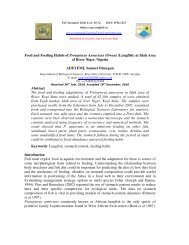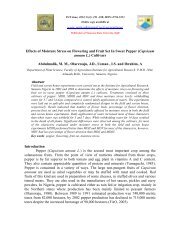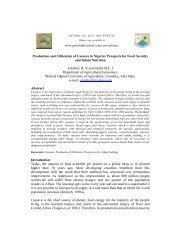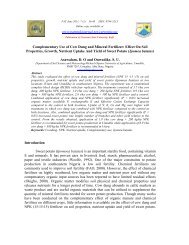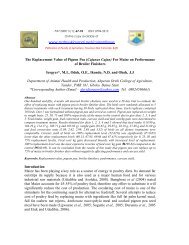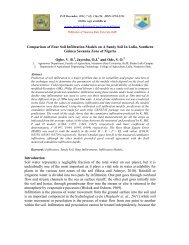View Publication - Production Agriculture and Technology Journal
View Publication - Production Agriculture and Technology Journal
View Publication - Production Agriculture and Technology Journal
- No tags were found...
Create successful ePaper yourself
Turn your PDF publications into a flip-book with our unique Google optimized e-Paper software.
PAT June, 2012; 8 (1): 153 -163; ISSN: 0794-5213<br />
Online copy available at<br />
www.patnsukjournal.net/currentissue<br />
<strong>Publication</strong> of Nasarawa State University, Keffi<br />
Soil Water Characteristics <strong>and</strong> structural stability of a Typic Paleustult Under<br />
Different Vegetation Cover.<br />
Enyioko, C. O 1 . Obi, M. E 2 . <strong>and</strong> Eneje, R. C 3* .<br />
1 Department of Forestry <strong>and</strong> L<strong>and</strong> Resources, Umuahia, Abia state.<br />
2 Department of Soil Science, Faculty of <strong>Agriculture</strong> University of Nigeria Nsukka, Enugu State.<br />
3 Department of Soil Science And Meteorology, Michael Okpara University of <strong>Agriculture</strong> Umudike,<br />
Nigeria.<br />
Email: chizma2001@ yahoo.com<br />
Abstract<br />
The effect of different vegetation cover on soil water characteristics <strong>and</strong> aggregate stability of<br />
a Typic Paleustult was carried out. The different cover management practices were bare<br />
fallow, (BF), cassava cultivation (CS), groundnut cover (GN), manured groundnut cover GN+<br />
PM) <strong>and</strong> Panicum maximum(PMC), while the soil properties studied were water drop<br />
energy(impact), macro porosity, micro porosity, saturated hydraulic conductivity, soil<br />
moisture content at 6kpa, soil aggregate stability, <strong>and</strong> penetration resistance. Data were<br />
subjected to analysis of variance using RCBD, <strong>and</strong> results show that soil resistance to<br />
penetration was highest in the bare fallow treatment (1.7kg/m 2 ) <strong>and</strong> lowest under the manured<br />
groundnut treatment (1.0kg/m 2 ), Soil total porosity <strong>and</strong> macro porosity were highest (50.84<br />
<strong>and</strong> 24.4% respectively) under the manured groundnut treatment <strong>and</strong> lowest (43.16 <strong>and</strong> 16%<br />
respectively) under the cassava plot. Saturated hydraulic conductivity was lowest in the<br />
cassava plot (23.3cm/h) but highest in the manured groundnut plot. The management practices<br />
significantly increased the number of water drops <strong>and</strong> the energy required to breakdown soil<br />
aggregates to pass through a 4.75mm sieve. The highest drop number <strong>and</strong> energy values were<br />
obtained for aggregates formed under Panicum cover whereas the lowest values were<br />
obtained for aggregates of the bare soil The percent aggregate stability > 0.5 was not<br />
statistically significant but was highest for the Panicum maximum treatment closely followed<br />
by the bare fallow treatment <strong>and</strong> GN+PM treatment. The overall trend in changes in soil<br />
water properties (Ksat, PT, <strong>and</strong> macro-porosity) was BF≤ CS
PAT 2012; 8 (1): 153-163: ISSN: 0794-5213; Enyioko et al,: Soil Water Characteristics ……….154<br />
instance found that ground cover control infiltration, while Lugo Lopez et. al, (1981)<br />
reported that infiltration is a function of soil properties such as bulk density, pore size<br />
distribution <strong>and</strong> aggregate stability. According to Adeoye (1982), deep tillage of Alfisol<br />
in Northern Nigeria result in increased porosity, while Tollner et. al, (1984) reported<br />
that beneficial effects of tillage on soil include an in increase the number of drainage<br />
pores in the soil. According to Papendick <strong>and</strong> Campell (1981), water retention in soils is<br />
influenced by texture, organic matter content <strong>and</strong> the physical composition of the soil.<br />
Soil with high amount of clay content <strong>and</strong> organic matter for instance hold considerably<br />
more gravimetric water at a given water potential than soil with a high content of s<strong>and</strong>.<br />
Also, Mbagwu <strong>and</strong> Ekwealor (1990) reported high moisture retention for different soils<br />
amended with brewer’s spent grain, while Mbagwu (1989) reported that addition of<br />
organic matter at any rate significantly increased soil water retention except at<br />
1.500kpa. However, for exposed soils especially highly degraded soils in the tropics<br />
water retention is reduced <strong>and</strong> this is attributable to runoff <strong>and</strong> possibly a reduction in<br />
porosity due to high bulk density.<br />
Therefore, in this study we set out to study the water characteristics of a Typic<br />
paleustult (Nkpologu s<strong>and</strong>y loam soil) under bare fallow, cassava cultivation,<br />
leguminous plant (groundnut) <strong>and</strong> grass plant (Panicum maximum) management. The<br />
main objective was to relate these characteristics of the soil as well as determine which<br />
of these cover crop management type best influenced the soil property for crop growth.<br />
Material <strong>and</strong> Methods<br />
Experimental site<br />
The experiment was carried out at the University of Nigeria Nsukka, teaching <strong>and</strong><br />
Research farm located on latitude 06 o 5 2’N <strong>and</strong> longitude 07 o 24’E. The area has an<br />
annual rainfall of about 1700mm. The rainfall distribution is bimodal, a wet (April to<br />
October) <strong>and</strong> dry (November to March) season (Obi, 1982). The soil is deep, porous<br />
<strong>and</strong> red to brownish red derived from s<strong>and</strong>y deposits of false bedded s<strong>and</strong> stone. It is an<br />
Ultisol belonging to Nkpologu series <strong>and</strong> is classified as Typic paleustult (Nwadialo,<br />
1989).<br />
Field layout<br />
The field was laid out in R<strong>and</strong>omized complete Block Design (RCBD) with four<br />
replications. Four treatments were applied on the plots of 4m X5m with 0.5m spacing<br />
between plots <strong>and</strong> 1m between replications. The treatments were as follows;<br />
( i) Bare fallow (BF)- The l<strong>and</strong> was placed under fallow <strong>and</strong> was kept free of<br />
weed <strong>and</strong> crop through out the period of research, weeding was done manually.
PAT 2012; 8 (1): 153-163: ISSN: 0794-5213; Enyioko et al,: Soil Water Characteristics ……….155<br />
(ii) Cassava cultivation (CS); Cassava (Manihot esculentus var. NR8082) was<br />
planted on flats at a spacing of 1m X 1m giving a plant population of 10,000st<strong>and</strong>s per<br />
hectare.<br />
(iii) Panicum maximum cultivation (PMC); Guinea grass was allowed to<br />
dominate this plot for about three years.<br />
(iv) Groundnuts (Arachis hypogea) cultivation (GN); Groundnuts was planted on the<br />
flat at a spacing of 25cm X 50 cm (intra <strong>and</strong> inter row respectively) giving a total plant<br />
population of 76,000st<strong>and</strong>s per hectare which ensured proper ground cover.<br />
Sample collection<br />
Undisturbed soil samples were collected at the start of the experiment using core of<br />
dimensions 7.6X 7cm (length <strong>and</strong> diameter). Auger soil samples were also collected<br />
from0-15cm depth <strong>and</strong> both samples subjected to physical <strong>and</strong> chemical analysis.<br />
Laboratory Analysis<br />
Soil water content<br />
This was determined by the gravimetric method, the soil core samples were<br />
saturated in water <strong>and</strong> their weights at saturation were taken, then the samples are oven<br />
dried at 105 0 c for 24hours. Dry samples were cooled in a desicator <strong>and</strong> reweighed<br />
again.<br />
Moisture content was computed as;<br />
Moisture content =Ww – Dw x 100<br />
Dw 1<br />
Where;<br />
Ww = Wet weight of soil<br />
Dw = Dry weight of soil<br />
Soil bulk density, porosity <strong>and</strong> pore-size distribution<br />
Core samples were collected from experimental plots carefully trimmed <strong>and</strong> one<br />
end tied with calico cloth. The weight of core samples were taken <strong>and</strong> samples were<br />
soaked for 24hours in a pan containing about 5cm of water after 24hrs, the water level<br />
in the pan was raised to ensure complete saturation of the soil samples. Then the<br />
samples were weighed after 24hrs <strong>and</strong> placed on a tension table adjusted for 60cm of<br />
tension for 24hrs, the soil core samples were removed from the tension tables <strong>and</strong><br />
weighed <strong>and</strong> oven-dried for 48hrs at a temperature of 105 o C <strong>and</strong> weighed again.<br />
Calculations were made as follows:
PAT 2012; 8 (1): 153-163: ISSN: 0794-5213; Enyioko et al,: Soil Water Characteristics ……….156<br />
(i) Bulk density = Oven-dry mass(g)<br />
Vol of soil (cm3)<br />
(ii) Total porosity= Vol of water at saturation X 100<br />
Vol of soil 1<br />
(iii) Air space porosity= Vol of water drained at 60cm tension X 100<br />
Vol. of soil 1<br />
(iv) Capillary porosity= Vol of water retained at 60 cm tension X 100<br />
Vol of soil 1<br />
Saturated hydraulic conductivity<br />
This was determined using the modified Klute (1965), method Saturated hydraulic<br />
conductivity was calculated as follows:<br />
Ksat = QL<br />
∆HAT<br />
Where:<br />
Ksat = saturated hydraulic conductivity (cm/hr) ; Q= quantity of water (cm3)<br />
L= length of core (cm) ; H = hydraulic gradient (cm)<br />
A= cross-sectional area of core (cm2) ; T= Time elapsed (hr)<br />
Aggregate stability<br />
A modification of Yoders (1936) wet sieving technique was used to determine<br />
aggregate stability. The set of sieves used had size openings ranging from 2mm to<br />
0.25mm (2, 1, 0.5 <strong>and</strong> 0.25mm). A 25g soil (pre-sieved through 4.25mm) was soaked<br />
for 5minutes on the top-most sieve. Shaking was done by vertically oscillating the set of<br />
sieve in water for 80 times. The resistant aggregates were carefully washed out of the<br />
sieve into evaporating dishes <strong>and</strong> oven-dried for about 24hrs. The sample weights were<br />
recorded. To correct for s<strong>and</strong> in the sample, soils in sieves of 2mm to 0.5mm were<br />
returned to a dish <strong>and</strong> soaked with 5ml of sodium hexametaphosphate. Enough water<br />
was added to cover the aggregates. Thereafter, the suspension was stirred for about 30<br />
minutes <strong>and</strong> s<strong>and</strong> particles larger than 0.5mm were removed by washing dispersed<br />
aggregates through a 0.5mm sieve, the s<strong>and</strong> was washed into an evaporating dish <strong>and</strong><br />
oven dried for 24hrs at a temperature of 105 o C, the weight of s<strong>and</strong> was taken.<br />
Aggregate stability was calculated using the formula:<br />
Percent aggregate stability (%AS) = wt of WSA>0.5mm-wt of s<strong>and</strong> X 100<br />
Wt of sample-wt of s<strong>and</strong> 1
PAT 2012; 8 (1): 153-163: ISSN: 0794-5213; Enyioko et al,: Soil Water Characteristics ……….157<br />
Other soil properties determined in the laboratory include, soil water retention,<br />
which was determined by the hanging column of water method as described by Richard<br />
(1957) using water retention at 60 cm tension. Soil particle size, was determined by the<br />
hydrometer method Bouyoucos (1951), with sodium hexameaphosphate as the<br />
dispersant. Total aluminum was determined by the method of Vogel (1961), <strong>and</strong> total<br />
iron determined by colorimetric methods AOAC (1970). Soil P H was determined in<br />
water <strong>and</strong> KCl in 1:2.5 soil water suspension using p H meter (Jackson 1958)<br />
Statistical Analysis<br />
Data obtained from the study were subjected to analysis of variance test in<br />
R<strong>and</strong>omized Complete Block Design as outlined by Steel <strong>and</strong> Torrie (1980). Simple<br />
linear correlation of selected parameters was carried out as described by Little <strong>and</strong> Hills<br />
(1972).<br />
Result <strong>and</strong> Discussions<br />
The soil used for this study is a s<strong>and</strong>y loam (Table 1). The dominance of s<strong>and</strong> fraction is<br />
attributable to the dominance of parent material, in this case, -false-bedded s<strong>and</strong>stone<br />
(Akamigbo <strong>and</strong> Igwe, 1990).<br />
The soil management practices increased organic matter content of the soil at the end of<br />
the experiment except the plot planted with groundnut alone that recorded a reduction in<br />
percent OC content in the soil at the end of the experiment (Table 3); this is expected<br />
since groundnut a legume could mobilize OC in the soil for profuse foliage production.<br />
Also the plant cover system resulted in reduced compaction in the soil as indicated by a<br />
reduction in bulk density of the soils except the plot planted up with cassava, which<br />
experienced an increase in bulk density indicating poor structural status of the soil since<br />
increased BD is associated with high clogging of soil pores <strong>and</strong> compaction with hard<br />
pan formation. The trend in BD explains the observation in the total porosity of where<br />
the percent age of pore space reduced up to 22% in the cassava plot. Also this result<br />
agree with the observation of Adekalu <strong>and</strong> Osunbitan (2001) that BD is indirectly<br />
affected by cultivation, thus variations in BD <strong>and</strong> macro porosity are attributable to l<strong>and</strong><br />
use. Earlier, Obi <strong>and</strong> Nnabude (1988), reported significant reduction in bulk density<br />
under continuous Centrosema pubesscens <strong>and</strong> Panicum maximum covers <strong>and</strong> attributed<br />
this to high root density <strong>and</strong> high organic matter accumulation under continuous covers.<br />
However the soil moisture content at 6kpa was highest in this same plot, indicating that<br />
compaction may have resulted in ponding of the soil. This agrees with the observation<br />
of Obi <strong>and</strong> Nnabude (1988), since an increase in bulk density is associated with
PAT 2012; 8 (1): 153-163: ISSN: 0794-5213; Enyioko et al,: Soil Water Characteristics ……….158<br />
decreased pore volume <strong>and</strong> increased micro-porosity <strong>and</strong> pore space discontinuity, thus<br />
affecting the consistency of the soil <strong>and</strong> its capacity to conduct <strong>and</strong> retain water<br />
(Richards <strong>and</strong> Wadeigh, 1952).<br />
Table 1: Physico-chemical characteristics of soil at the start of the experiment<br />
Soil Property<br />
Mean value<br />
S<strong>and</strong> (%) 61.3<br />
Silt (%) 11.0<br />
Clay (%) 27.7<br />
Textural class<br />
S<strong>and</strong>y loam<br />
Dry Bulk density(g/cm3) 1.48<br />
Total porosity(%) 55.94<br />
Macro porosity(%) 28.08<br />
Micro porosity (%) 27.85<br />
Saturated hydrualic conductivity 24.76<br />
Infiltration rate (cm/h) 50.28<br />
Soil p H (H2O) 4.8<br />
Soil p H (KCl) 3.8<br />
Organic carbon (%) 0.84<br />
Total Al(Meq/100soil) 0.24<br />
Total Fe(Meq/100soil ) 35.27<br />
Aggregate Stability (%) 96.68<br />
Table 2: Property of the poultry manure used in the study<br />
Property<br />
Poultry manure<br />
OM (%) 33.17<br />
Total N (%) 2.86<br />
Total P (%) 2.00<br />
Total K (%) 1.50<br />
C:N Ratio 7:1<br />
C:P ratio 10:1
PAT 2012; 8 (1): 153-163: ISSN: 0794-5213; Enyioko et al,: Soil Water Characteristics ……….159<br />
Table 3 : Soil Physicochemical properties at the end of the experiment.<br />
Soil property<br />
L<strong>and</strong> Management practice<br />
Bare<br />
Fallow<br />
Cassava Panicum<br />
Max.<br />
Groundnut Groundnut+Poultry<br />
Manure<br />
OM (%) 1.05 0.88 1.10 0.73 1.36 Ns<br />
pH (H2O) 4.3 4.4 4.6 4.4 5.3 Ns<br />
pH(KCl) 3.9 4.0 4.0 3.9 4.9 Ns<br />
Fe (meq/100gsoil) 31.90 42.01 46.14 42.75 38.15 Ns<br />
Al (meq/100gsoil) 0.14 0.23 0.17 0.14 1.79 1.179<br />
Fe/Al<br />
227.86 182.65 271.41 305.36 -<br />
(meq/100gsoil)<br />
BD(mg/m 3 ) 1.44 1.51 1.43 1.45 1.42 Ns<br />
Micro-<br />
25.1 26.8 23.5 22.7 26.5 Ns<br />
Porosity(%)<br />
Macro-<br />
20.4 16.4 22.5 22.4 24.4 4.83<br />
Porosity(%)<br />
Total porosity (%) 45.53 43.16 46.00 45.11 50.84 3.349<br />
Ksat (cm/h) 28.6 23.3 55.6 35.2 61.6 22.63<br />
Soil moisture 0.25 0.27 0.23 0.23 0.27 0.03<br />
(6kpa)<br />
Water drop* 41 48 87 41 68 28.05<br />
Penetro-meter 1.7 1.3 1.1 1.2 1.0 0.32<br />
resistance( kg/m 2 )<br />
Kinetic energy 6.42 7.52 x10 -6 1.34 x10 -5 6.42 X10 6 1.03X10 5 -<br />
x10 -6<br />
AS >0.5 (%) 90.30 87.30 93.9 82.1 89.3 Ns<br />
*Mean of 15 determinations<br />
F-LSD 0.05<br />
Soil structural stability assessed by percent aggregate stability (AS>0.5) indicated<br />
stability was higher for all the cover crop management practice at the end of the<br />
experiment, however the plot supporting the Panicum maximium had the highest level<br />
of stability of micro aggregates (about 94%), this was closely followed by the bare<br />
fallow (about 90%) with the least percent aggregate stability found in plots planted with<br />
groundnuts. Similar trend was observed with the OC content at the end of the<br />
experiment while Fe/Al ratio showed a reversal, with GN, which had the lowest AS%<br />
<strong>and</strong> OC, suggesting that GN must have provide an environment that encouraged higher<br />
concentration of Fe but lower concentration of Al. his observation agrees with the report<br />
of Jonsson <strong>and</strong> Abubakar (1996), that fallow play important roles in soil fertility <strong>and</strong><br />
crop yield, also different l<strong>and</strong> management type resulted in varying inputs in the total<br />
OM content of the soil, however according to Lugo et al (1981) <strong>and</strong> Houghton et al<br />
1991) the rate <strong>and</strong> duration of the increase will depend on the method of conversion ,<br />
intensity of the subsequent l<strong>and</strong> use as well as the climatic, physical <strong>and</strong> chemical
PAT 2012; 8 (1): 153-163: ISSN: 0794-5213; Enyioko et al,: Soil Water Characteristics ……….160<br />
property of the soil under study. Generally, in this study, higher contents of Fe/Al ratio<br />
suggest soil acidity <strong>and</strong> this corresponds with the acidity level as indicated by the<br />
observed pH values ranging from 3.9 to 4.4 for all the cover management practices<br />
studied.<br />
Penetrometer resistance is an index of soil surface structure, the penetrability of a soil to<br />
any probing instrument is a rheological property which depends on the texture,<br />
structure, mineralogical composition, moisture content <strong>and</strong> compactness of the soil, thus<br />
in this study with no significant differences in BD <strong>and</strong> moisture content it is expected<br />
that the penetration resistance, would depend more on the mineralogical compositions<br />
of different plots which can be influenced by the management practice, thus in this<br />
study, the soils resistance to penetration was significantly(p= 0.05) influenced by<br />
management practice, the manure <strong>and</strong> cover management practice reduced penetration<br />
resistance relative to the bare fallow (Table 3), this also agrees with the report of kuldip<br />
et al., (1996).<br />
The management practices significantly increased the number of water drops<br />
<strong>and</strong> the energy required to breakdown soil aggregates to pass through a 4.75mm sieve.<br />
The highest drop number <strong>and</strong> energy values were obtained for aggregates formed under<br />
Panicum cover whereas the lowest values were obtained for aggregates of the bare soil.<br />
This resistance to breakdown impact could be attributed directly to the effect of<br />
Panicum maximuim on soil organic matter fraction resulting in soil aggregate formation<br />
<strong>and</strong> stabilization or indirectly to the cementation of clay particles by iron <strong>and</strong><br />
aluminium oxides as indicated by a positive <strong>and</strong> significant correlation (r =0.819)<br />
between water drop impact <strong>and</strong> iron content in this study. Earlier reports of Mbagwu<br />
<strong>and</strong> Bazzoffi (1998) also suggest that for an aggregate to be destroyed, the detaching<br />
force of raindrop must overcome the intrinsic resisting force of soil aggregate, which<br />
depends on the cohesive forces holding the structural units together of which organic<br />
matter, iron <strong>and</strong> aluminum play important role.<br />
The management practices also influenced total porosity <strong>and</strong> macro porosity of the soil,<br />
the manure groundnut plot had the highest values for total porosity <strong>and</strong> macro porosity<br />
while he lowest values were obtained in the cassava plots. There were however no<br />
significant differences in soil bulk density under the different management practices <strong>and</strong><br />
this could be attributed to the organic matter contents of these plots which were<br />
generally very low, this observation agree with the findings of Thomas et. al, (1996)<br />
that indicated that the amount of organic matter in any soil significantly affects its bulk<br />
density. There were significant differences in saturated hydraulic conductivity (Ksat)<br />
for the different management practices (Table3), Higher Ksat in the GN+PM, PMC <strong>and</strong>
PAT 2012; 8 (1): 153-163: ISSN: 0794-5213; Enyioko et al,: Soil Water Characteristics ……….161<br />
GN plots is an indication of the ameliorative effect of these practices on soil structure as<br />
indicated by improvements in total porosity <strong>and</strong> Ksat in this study. This observation is<br />
confirmed by a significant <strong>and</strong> positive correlation(r= 0.8387, P= 0.01) obtained<br />
between total porosity <strong>and</strong> Ksat. (Table 4). This agrees with the findings of Obi <strong>and</strong><br />
Ofoduro (1999).<br />
Table 4: Correlation coefficients of selected parameters<br />
Parameter<br />
r-value<br />
TP vs. Ksat 0.8387*<br />
TP vs. s<strong>and</strong> 0.8376**<br />
Ksat vs. s<strong>and</strong> 0.9294**<br />
BD vs. penetrometer resistance<br />
0.1727 ns<br />
Water drop impact vs. Total iron 0.8109**<br />
** Significant at p= 0.01 ns =non significant<br />
Conclusion<br />
Conclusively, the management practices significantly influenced the water properties of<br />
the soil under study. For instance, the highest drop number <strong>and</strong> energy values were<br />
obtained for aggregates formed under Panicum cover whereas the lowest values were<br />
obtained for aggregates of the bare soil, the overall trend in changes in soil water<br />
properties (Ksat, PT, <strong>and</strong> macro-porosity) was BF≤ CS
PAT 2012; 8 (1): 153-163: ISSN: 0794-5213; Enyioko et al,: Soil Water Characteristics ……….162<br />
Houghton, R.A. Skole <strong>and</strong> Lelkowiz, (1991). Changes in L<strong>and</strong> use of Latin America<br />
between 1850 <strong>and</strong> 1985. Ecoli. Mgt 38: 173-199.<br />
Jackson, M. L. (1958). Soil Chemical analysis. Prentice-Hall, Englewood Cliffs, N. J.<br />
498pp.<br />
Jonsson, K. <strong>and</strong> Abubakar, P. (1996). Tree Fallow, a comparison between five tropical<br />
Trees SPPS Biology <strong>and</strong> Fertility of Soil 23: 50-56.<br />
Klute , A (1965). Laboratory measurement of hydraulic conductivity of saturated soils .<br />
In: C. A. Black D. D Evans, J. L. White , L E. Esminger <strong>and</strong> F. E. Clark (eds.)<br />
Methods of soil analysis, Part 1 Amer. Soc of agronomy. Madison, W. I. 9: 210-<br />
221.<br />
Kuldip, K., Gajri, P. R. <strong>and</strong> Arora, V. K. (1996). Estimating penetration resistance from<br />
soil physical properties. <strong>Journal</strong> of Indian Society of Soil Science 44: 375-377.<br />
Little T. M. <strong>and</strong> Hills, F. J. (1972). Statistical Methods ofor Agricultural Research, First<br />
Edition. Agricultural Extension Unversity of California, Berkrley 94720, U.S.A.<br />
242pp<br />
Lugo, Lopez, M. A., Wolf, J. M. <strong>and</strong> Perez Escolar, R. (1981). Water loss, intake,<br />
movement retention <strong>and</strong> availability in major soils of Puerto Rico. University of<br />
Puerto Rico Bulletin 264. pp 7-8.<br />
Mbagwu, J. S. C. (1989). Effect of organic amendments on some physical properties of<br />
a tropical ultisol. Biological Wastes 28: 1-13.<br />
Mbagwu ,J. S. C. <strong>and</strong> Bazzoffi, P. (1998). Soil characteristics related to resistanec of<br />
breakdown of dry soil aggregates by water drops. Soil <strong>and</strong> Tillage Res. 45: 133-<br />
145.<br />
Mbagwu, J. S. C. <strong>and</strong> Ekwealor, G, C, (1990). Agronomic potential of brewer’s spent<br />
grain. Biological Wastes, 34: 335-347.<br />
Nwadialo, B. E. (1989). Soil – l<strong>and</strong>scape relationship in Udi-Nsukka Plateau, Nigeria.<br />
Catena 16: 11-120.<br />
Obi, M. E. (1982). Runoff <strong>and</strong> soil loss from an oxisol in southeastern Nigeria under<br />
various management practices. Agric. Water Management 5: 193-203.<br />
Obi, M. E. <strong>and</strong> Nnabude, P. C. (1988). The effects of different management practices on<br />
physical properties of a s<strong>and</strong>y loam soil in Southeasthern Nigeria. Soil <strong>and</strong><br />
Tillage Res.12 : 81-90.<br />
Obi , M. E. <strong>and</strong> Ofoduru, C. O. (1997). The effect of soil amendment on the physical<br />
properties of a severely degraded s<strong>and</strong>y loam soil in South Easern Nigeria. In<br />
Proc. 24 th Annual Conf. of Soil Science society of Nigeria” The national.<br />
conference on soil management for food security”. Usman Danfodo University,<br />
Sokoto Nigeria. pp. 30-35.<br />
Papendick, R. I . <strong>and</strong> Campbell, G. S. (1981). Theory <strong>and</strong> measurement of water
PAT 2012; 8 (1): 153-163: ISSN: 0794-5213; Enyioko et al,: Soil Water Characteristics ……….163<br />
potential . In: J. F. Parr, W.R, Gardner , <strong>and</strong> L. F. Elliot (eds0 Water<br />
Potential Relations in soil Microbiology, Special publication no. 9 Soil Science<br />
Soc amer, Madison Wiscoson pp1-22.<br />
Richards, L. A. (1957). Soil Moisture. USDA Year book Separate 49-50.<br />
Richards, L. A. <strong>and</strong> Wadleigh, C. H. (1952). Physical changes in soils. In: Soil Physical<br />
conditions <strong>and</strong> plant growth (B. T. Shaw ed) . Academic Press. N. Y. 253-301.<br />
Steel , R. G. D. <strong>and</strong> Torrie, J. H. (1980). Principles <strong>and</strong> procedures of statistics: A<br />
Biometric Approach (2 nd Ed.), New York McGraw-Hill Book Co. Inc. XXI :<br />
633pp.<br />
Thomas , G. W., Haszler, G. R. <strong>and</strong> Blevins, R. L. (1996). The effects of organic matter<br />
<strong>and</strong> tillage of maximum compatibility of soil using the protector test. Soil<br />
Science 161: 502-508.<br />
Tollner, E. W. Hargrove, W. L. <strong>and</strong> Laongdale, G. (1984). Influence of conventional<br />
<strong>and</strong> no-till practices on soil physical properties in the southern Piedmont.<br />
<strong>Journal</strong> of Soil <strong>and</strong> water conservation. 39: 72-76.<br />
Vogel, A. I. (1961). Determination of Al using Erio-Chrome Black T as an indicator<br />
(Back titration) In: Quantitative analysis (3 rd ed.) Eng. Lang Book Soc., <strong>and</strong><br />
Longman. Pp 436.<br />
Wood, J. C. Wood, M. K. <strong>and</strong> Tromble, J. M. (1987). Important factors influencing<br />
water infiltration <strong>and</strong> sediment production on arid l<strong>and</strong>s in New Mexico<br />
<strong>Journal</strong> of Arid environment. 12: 111-118.<br />
Yoder, R. E. (1936). A direct method of aggregate analysis of soils <strong>and</strong> a study of the<br />
physical nature of erosion losses. J. Am. Soc. Agron. 28: 337.



